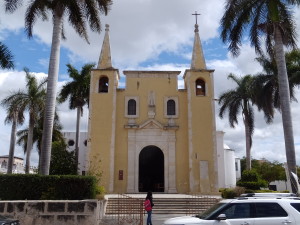We barely scratched the surface of restaurants in this sprawling city. I am only mentioning the ones that were so exceptional that I wish I could walk out my door and they would be right on the corner.
K’u’-uk. Calle 58A#488 por 27 y 27A. Col. Centro (Monumento al Patrio) Has the distinction of being named one of 100 restaurants in the world to visit. 52 999 944 3377 Closed on Mondays. Get 15-course tasting menu, which lasted three hours for us. We feasted on elaborate and artful, even downright architectural appealing dishes. After each course, everything was removed from the table and an entirely new table setting was placed before us. Most of the dishes and cutlery were handmade. The whole meal was so well orchestrated that I often felt like I was watching a gripping movie. This meal was memorable, which means I will never, ever forget it. Often, we go somewhere, eat a fine meal that comes with a hefty price, then 24-hours later, we have forgotten what we ate. OK. We might remember the dessert. Not so with K’u’uk. With alcohol our entire bill was $135 US. If your server is not too busy, ask him to give you a tour of the restaurant’s library and their intriguing laboratory, which could easily be Mr. Science’s chemistry lab.
–Oliva Kitchen, comida italiana, Calle 47 & Esquina con 54 S/N Centro, (999.923.2248). We loved this charming little neighborhood place that we ate here twice. Everything is handmade and fresh. The owners have two restaurants. We always ate in this tiny one that only has 8 tables. The other one Oliva Enoteca Calle 47 Esquina Calle , (54. 999.923.3081 ) in Centro has more seafood on their menu and totally different atmosphere (much larger space). Heard great things about it as well from several guests at Hotel Julamis where we were staying. Go early to these places or make reservations.
Apoala Mexican Fusion Cuisine in the newly restored Santa Lucia Park. Calle 60 471-2 X 55 | Portales de Santa Lucía, Centro, +52 999 923 1979, 1pm to 12 a.m. Beautiful place, with dining outside or inside. Great meal and excellent service by a personable and knowledgeable server. You can park behind the Santa Lucia square, turning left off 60 into a modern and very pretty parking lot. The restaurant is located under the arches next to the Ki Xocolatl store and chocolateria.
Ki’Xocolatyl, Chocolate shop. Av. Andrés García Lavín 315, San Antonio Cucul, 97116 Mérida, Yuc., Mexico, Ph. 52 999 920 5869, 11 a.m. at 8 pm.






